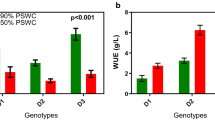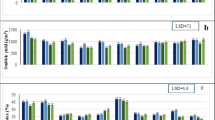Abstract
Scientific data on emmer wheat’s response to N and water supplies is scarce. Two field experiments were conducted on a group of five emmer wheat landraces (Joneghan, Zarneh, Singerd, Shahrekord, Khoygan), a durum, and a bread wheat genotype. In the first experiment, the genotypes were subjected to 30 (N-limited) and 100 kg N ha–1 (N-supplied) at non-stress and drought stress conditions. In the second experiment, responses of these genotypes to the mentioned N supplies were studied under dryland and dryland + terminal complementary irrigation conditions. Water deprivation (being either due to the imposed drought stress or the dryland condition) led to decreases in chlorophyll concentration, maximum quantum efficiency of photosystem II, relative water content, grains/spike, spikes/plant, 1000-grains weight, grain yield, plant above-ground dry mass, and N use efficiency of the examined wheat genotypes. However, emmer wheat genotypes tended to vary less in response to water supply at least in terms of a majority of the traits, including grain yield (28–30% vs 40–58% drought-induced decreases for emmer and improved wheats, respectively) and above-ground dry mass (12–17% vs 23–40% drought-induced decreases for emmer and improved wheats, respectively). Increase in N supply led to decreases in grains/spike, spikes/plant, 1000-grains weight, and grain yield of the emmer wheats, despite increases in these grain yield attributes and grain yield of the durum and bread wheats. Results were indicative of greater protein content (15.7 vs 12.4% for non-stressed emmer and improved wheats, respectively) but a smaller grain yield (2985 vs 7275 kg ha−1 for non-stressed emmer and improved wheats, respectively), harvest index, and N use efficiency in the emmer wheats, compared to the durum and bread wheats, across different N and water supplies. Our findings were novel in that the emmer wheat was found more sustained across different water availabilities and no responsive to N levels that are beneficial to the durum and bread wheats.

Similar content being viewed by others
Abbreviations
- ANOVA:
-
Analysis of variances
- Cars:
-
Carotenoids
- Chl:
-
Chlorophyll
- dryland + CI:
-
Dryland + complementary irrigation
- HI:
-
Harvest index
- LSD:
-
Least significant difference
- Fv/Fm :
-
Maximal quantum efficiency of PSII
- N:
-
Nitrogen
- NIR:
-
Near infrared spectroscopy
- NUE:
-
N use efficiency
- RCBD:
-
Randomized complete block design
- SDM:
-
Plant above-ground dry mass
References
Abdehpour, Z., & Ehsanzadeh, P. (2019). Concurrence of ionic homeostasis alteration and dry mass sustainment in emmer wheats exposed to saline water: Implications for tackling irrigation water salinity. Plant and Soil, 440, 427–441. https://doi.org/10.1007/s11104-019-04090-1
Allen RG, Pereira LS, Raes D, Smith M (1998) Crop evapotranspiration: Guidelines for computing crop water requirements. FAO Irrg. Drain. Pap. 56. FAO, Rome
Anbessa, Y., Juskiw, P., Good, A., Nyachiro, J., & Helm, J. (2009). Genetic variability in nitrogen use efficiency of spring barley. Crop Science, 49, 1259–1269.
Arzani, A. (2011). Emmer (Triticum turgidum spp. dicoccum) flour and breads. In V. R. Preedy, R. R. Watson, & V. B. Patel (Eds.), Flour and breads and their fortification in health and disease prevention (pp. 69–78). London, Burlington: Academic Press, Elsevier.
Askari, E., & Ehsanzadeh, P. (2015). Osmoregulation-mediated differential responses of field-grown fennel genotypes to drought. Industrial Crops and Products, 76, 494–508.
Bates, L. S., Waldran, R. P., & Teare, I. D. (1973). Rapid determination of free proline for water studies. Plant and Soil, 39, 205–208.
Bavec, M., Narodoslawsky, M., Bavec, F., & Turinek, M. (2011). Ecological impact of wheat and spelt production under industrial and alternative farming systems. Renew Agric Food Syst, 27, 242–250.
D’Antuono LF, Bravi R (1995) The hulled wheat industry: Present developments and impact on genetic resources conservation. In: S. Padulosi, K. Hammer, & J. Heller (Eds.), Proceedings of the First International Workshop on Hulled Wheats, Tuscany, Italy. pp. 221–233.
Ghaouti, L., & Link, W. (2009). Local vs. formal breeding and inbred line vs. synthetic cultivar for organic farming: Case of Vicia faba L. Field Crops Research, 110, 167–172.
Kant, S., Bi, Y. M., & Rothstein, S. J. (2011). Understanding plant response to nitrogen limitation for the improvement of crop nitrogen use efficiency. Journal of Experimental Botany, 62, 1499–1509.
Kiani, M., Gheysari, M., Mostafazadeh-Fard, B., Majidi, M. M., Karchani, K., & Hoogenboon, G. (2016). Effect of the interaction of water and nitrogen on sunflower under drip irrigation in an arid region. Agricultural Water Management, 171, 162–172.
Liang, Z., Bronson, K. F., Thorp, K. R., Mon, J., Badaruddin, M., & Wang, G. (2014). Cultivar and N fertilizer rate affect yield and N use efficiency in irrigated durum wheat. Crop Science, 54, 1175–1183.
Lichtenthaler, H. K., & Wellburn, W. R. (1994). Determination of total carotenoids and chlorophylls a and b of leaf extracts in different solvents. Biochemical Society Transactions, 11, 591–592.
Longin, C. F. H., Ziegler, J., Schweiggert, R., Koehler, P., Carle, R., & Würschum, T. (2016). Comparative study of hulled (einkorn, emmer, and spelt) and naked wheats (durum and bread wheat): Agronomic performance and quality traits. Crop Science, 56, 302–311.
Lyudmila, S., Klimentina, D., Tatyana, P., Nikolay, T., & Urs, F. (2009). Antioxidative protection and proteolytic activity in tolerant and sensitive wheat (Triticum aestivum L.) varieties subjected to long-term field drought. Plant Growth Regulation, 58, 107–117.
Maaz, T., Pan, W., & Hammac, W. (2016). Influence of soil nitrogen and water supply on canola nitrogen use efficiency. Agronomy Journal, 108, 2099–2109.
Mahjourimajd, S., Taylor, J., Rengel, Z., Khabaz-Saberi, H., Kuchel, H., Okamoto, M., & Langridge, P. (2016). The genetic control of grain protein content under variable nitrogen supply in an Australian wheat mapping population. PLoS ONE. https://doi.org/10.1371/journal.pone.0159371
Marti, J., & Slafer, G. (2014). Bread and durum wheat yields under a wide range of environmental conditions. Field Crops Research, 156, 258–271.
Moragues, M., Garcia del Moral, L. F., Moralejo, M., & Royo, C. (2006a). Yield formation strategies of durum wheat landraces with distinct pattern of dispersal within the Mediterranean basin II. Biomass production and allocation. Field Crops Research, 95, 182–193.
Moragues, M., Garcia del Moral, L. F., Moralejo, M., & Royo, C. (2006b). Yield formation strategies of durum wheat landraces with distinct pattern of dispersal within the Mediterranean basin I: Yield components. Field Crops Research, 95, 194–205.
Morgounov, A., Keser, M., Kan, M., Küçükçongar, M., Özdemir, F., Gummadov, N., Muminjanov, H., Zuev, E., & Qualset, C. O. (2016). Wheat landraces currently grown in Turkey: Distribution, diversity, and use. Crop Science, 56, 3112–3124.
Murphy, K. M., Campbell, K. G., Lyon, S. R., Stephen, S., & Jones, S. S. (2007). Evidence of varietal adaptation to organic farming systems. Field Crops Research, 102, 172–177.
Muurinen, S., Slafer, G. A., & Peltonen-Sainio, P. (2006). Breeding effects on nitrogen use efficiency of spring cereals under northern conditions. Crop Science, 46, 561–568.
Ozturk, A., & Aydin, F. (2004). Effect of water stress at various stages on some quality characteristics of winter wheat. Journal of Agronomy and Crop Science, 190, 93–99.
Pan, X., Lada, R. R., Caldwell, C. D., & Falk, K. C. (2011). Water-stress and N-nutrition effects on photosynthesis and growth of Brassica carinata. Photosynthetica, 49, 309–315.
Peleg, Z., Saranga, Y., Yazici, A., Fahima, T., Ozturk, L., & Cakmak, I. (2008). Grain zinc, iron and protein concentrations and zinc-efficiency in wild emmer wheat under contrasting irrigation regimes. Plant and Soil, 306, 57–67.
Porcel, R., & Ruiz-Lozano, J. (2004). Arbuscular mycorrhizal influence on leaf water potential, solute accumulation and oxidative stress in soybean plants subjected to drought stress. Journal of Experimental Botany, 55, 1743–1750.
Pourazari, F., Vico, G., Ehsanzadeh, P., & Weih, M. (2015). Contrasting growth pattern and nitrogen economy in ancient and modern wheat varieties. Canadian Journal of Plant Science, 95, 851–860.
Sabzalian, M. R., Khashei, M., & Ghaderian, M. (2014). Artificial and hybrid Fuzzy Linear Neural Network-based estimation of seed oil content of safflower. Journal of the American Oil Chemists Society, 91, 2091–2099.
Sheibanirad, A., Mirlohi, A., Mohammadi, R., Ehsanzadeh, P., & Sayed-Tabatabaei, B. E. (2014). Cytogenetic and crossability studies in hulled wheat collected from Central Zagros in Iran. Plant Systematics and Evolution, 300, 1895–1901.
Slafer, G. A., Savin, R., & Sadras, V. O. (2014). Coarse and fine regulation of wheat yield components in response to genotype and environment. Field Crops Research, 157, 71–83.
Smart, R. E., & Bingham, G. E. (1974). Rapid estimates of relative water content. Plant Physiology, 53, 258–260.
Stallknecht, G. F., Gilbertson, K. M., & Ranney, J. E. (1996). Alternative wheat cereals as food grains: Einkorn, emmer, spelt, kamut, and triticale. In J. Janick (Ed.), Progress in new crops (pp. 156–170). ASHS Press.
Thomas, D. S., & Turner, D. W. (2001). Banana (Musa sp.) leaf gas exchange and chlorophyll fluorescence in response to soil drought, shading and lamina folding. Scientia Horticulturae, 90, 93–108. https://doi.org/10.1016/s0304-4238(00)00260-0
Tosti, G., Farneselli, M., Benincasa, P., & Guiducci, M. (2016). Nitrogen fertilization strategies for organic wheat production: Crop yield and nitrate leaching. Agronomy Journal, 108, 770–781.
Yousefzadeh Najafabadi, M., & Ehsanzadeh, P. (2017). Salicylic acid effects on osmoregulation and seed yield in drought-stressed sesame. Agronomy Journal, 109, 1414–1422.
Acknowledgements
The authors are grateful to Dr Gh. Saeidi for his valuable editing comments on the manuscript.
Author information
Authors and Affiliations
Contributions
PE designed the experiments, supervised the research work, and prepared the manuscript. MV conducted the Experiment 1 and collected and analyzed the data. VR conducted the Experiment 2 and collected and analyzed the data.
Corresponding author
Ethics declarations
Conflict of interest
The authors declare that they have no conflict of interest.
Rights and permissions
About this article
Cite this article
Ehsanzadeh, P., Vaghar, M. & Roushanzamir, V. Persistent Indifference of Emmer Wheats Grain Yield and Physiological Functions to Nitrogen Supply: Evidence from Two Irrigation Regimes and Dryland Conditions. Int. J. Plant Prod. 15, 391–405 (2021). https://doi.org/10.1007/s42106-021-00143-7
Received:
Accepted:
Published:
Issue Date:
DOI: https://doi.org/10.1007/s42106-021-00143-7




